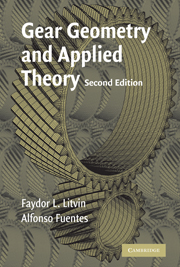Book contents
- Frontmatter
- Contents
- Foreword by Graziano Curti
- Preface
- Acknowledgments
- 1 Coordinate Transformation
- 2 Relative Velocity
- 3 Centrodes, Axodes, and Operating Pitch Surfaces
- 4 Planar Curves
- 5 Surfaces
- 6 Conjugated Surfaces and Curves
- 7 Curvatures of Surfaces and Curves
- 8 Mating Surfaces: Curvature Relations, Contact Ellipse
- 9 Computerized Simulation of Meshing and Contact
- 10 Spur Involute Gears
- 11 Internal Involute Gears
- 12 Noncircular Gears
- 13 Cycloidal Gearing
- 14 Involute Helical Gears with Parallel Axes
- 15 Modified Involute Gears
- 16 Involute Helical Gears with Crossed Axes
- 17 New Version of Novikov–Wildhaber Helical Gears
- 18 Face-Gear Drives
- 19 Worm-Gear Drives with Cylindrical Worms
- 20 Double-Enveloping Worm-Gear Drives
- 21 Spiral Bevel Gears
- 22 Hypoid Gear Drives
- 23 Planetary Gear Trains
- 24 Generation of Helicoids
- 25 Design of Flyblades
- 26 Generation of Surfaces by CNC Machines
- 27 Overwire (Ball) Measurement
- 28 Minimization of Deviations of Gear Real Tooth Surfaces
- References
- Index
7 - Curvatures of Surfaces and Curves
Published online by Cambridge University Press: 04 September 2009
- Frontmatter
- Contents
- Foreword by Graziano Curti
- Preface
- Acknowledgments
- 1 Coordinate Transformation
- 2 Relative Velocity
- 3 Centrodes, Axodes, and Operating Pitch Surfaces
- 4 Planar Curves
- 5 Surfaces
- 6 Conjugated Surfaces and Curves
- 7 Curvatures of Surfaces and Curves
- 8 Mating Surfaces: Curvature Relations, Contact Ellipse
- 9 Computerized Simulation of Meshing and Contact
- 10 Spur Involute Gears
- 11 Internal Involute Gears
- 12 Noncircular Gears
- 13 Cycloidal Gearing
- 14 Involute Helical Gears with Parallel Axes
- 15 Modified Involute Gears
- 16 Involute Helical Gears with Crossed Axes
- 17 New Version of Novikov–Wildhaber Helical Gears
- 18 Face-Gear Drives
- 19 Worm-Gear Drives with Cylindrical Worms
- 20 Double-Enveloping Worm-Gear Drives
- 21 Spiral Bevel Gears
- 22 Hypoid Gear Drives
- 23 Planetary Gear Trains
- 24 Generation of Helicoids
- 25 Design of Flyblades
- 26 Generation of Surfaces by CNC Machines
- 27 Overwire (Ball) Measurement
- 28 Minimization of Deviations of Gear Real Tooth Surfaces
- References
- Index
Summary
INTRODUCTION
The information on surface curvatures is required for computerized simulation of contact of gear tooth surfaces (see Chapter 9), and grinding of ruled undeveloped surfaces (see Chapter 26). The main ideas of surface curvatures have been developed in differential geometry by many distinguished scientists. This chapter provides condensed information about the basic equations of surface curvatures. For more details, we refer the reader to Nutbourne & Martin [1988], Finikov [1961], Favard [1957], Rashevski [1956], and Vigodsky [1949]. The chapter covers the following basic topics:
Representation of a spatial curve in 3D-space and on a surface
Geodesic and normal curvatures
Curve and surface torsions
First and second fundamental forms
Principal curvatures and directions and three types of surface points.
SPATIAL CURVE IN 3D-SPACE
Osculating Plane
Figure 7.2.1 shows spatial curve L1ML2. The osculating plane is the limiting position of such a plane that passes through curve points M1, M, and M2 as M1 and M2 approach M. The osculating plane for a curve at its regular point M is formed by the tangent to the curve and the acceleration vector for the same point.
The osculating plane and the curve are in tangency of second order. The osculating plane is an exceptional tangent plane: the deviations of the curve from the osculating plane are of different signs at two sides from the point of tangency, and the curve is above and below the plane (see points L1 and L2 in Fig. 7.2.1).
- Type
- Chapter
- Information
- Gear Geometry and Applied Theory , pp. 153 - 201Publisher: Cambridge University PressPrint publication year: 2004
- 1
- Cited by



